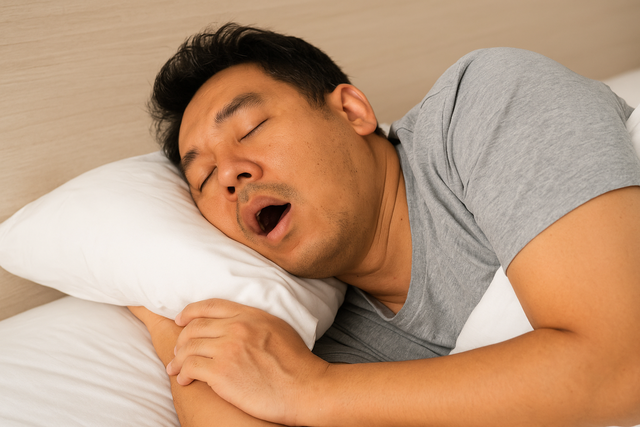Master - Specialist Doctor 2 Le Nhat Vinh, in charge of the Department of Interdisciplinary Eye - Ear Nose Throat - Dentistry - Dermatology, Nam Sai Gon International General Hospital, answers: Snoring and sleep apnea are respiratory disorders during sleep, characterized by repeated episodes of stopping or reducing the flow of air. This condition reduces the amount of oxygen in the blood and causes the patient to wake up frequently, causing sleep interruptions and loud snoring.
Sleep apnea is primarily caused by two main mechanisms: airway obstruction and central respiratory control disorders. Clearly and accurately distinguishing the cause helps doctors choose the appropriate and effective treatment regimen for each patient.

Being overweight is one of the major risk factors for loud snoring and sleep apnea.
PHOTO: AI
Being overweight is a risk factor for loud snoring and sleep apnea.
When the throat and tongue muscles relax too much, causing the airway to narrow or become blocked, the brain has to "wake up" the body to breathe again, causing loud, intermittent snoring, accompanied by symptoms such as daytime sleepiness, dry mouth, morning headaches, irritability and decreased concentration.
Major risk factors:
- Overweight, obesity: Fat around the neck and throat, causing airway compression.
- Gender: Men are twice as likely to be affected as women.
- People over 40 and postmenopausal women are more susceptible.
- Structural abnormalities of the airway such as short neck, large tongue, enlarged tonsils, deviated nasal septum.
- Alcohol, sedatives: Relax throat muscles, increasing the risk of obstruction.
- Genetic factors: Family members have sleep apnea due to airway obstruction.
In the case of Ms. Thanh Ha's husband, with obesity, frequent alcohol consumption, middle age and being a male, he is in the high-risk group for obstructive sleep apnea.

Need to see a doctor to know the cause of snoring
PHOTO: TH
Central sleep apnea - rare but no less dangerous
Central sleep apnea is a condition in which the brain does not send signals to control breathing; the airway remains open but the patient does not breathe. Usually there is no snoring, easy to miss, accompanied by frequent awakenings, shortness of breath, anxiety, insomnia, prolonged fatigue, often seen in people with cardiovascular or neurological diseases.
Major risk factors:
- Central nervous system disorders: Stroke, traumatic brain injury, or spinal cord injury.
- Heart failure, congestive heart failure: Causes poor circulation and disrupts respiratory signals.
- Use of respiratory depressants: Prolonged use of opioids and benzodiazepines inhibits the activity of the respiratory center.
- Older age: In older adults, respiratory function naturally declines, increasing the risk of disease.
With the above condition, you should take your loved one to a reputable medical facility for comprehensive screening, including underlying diseases such as cardiovascular and neurological diseases, to accurately determine the cause and clearly classify obstructive or central sleep apnea, thereby choosing the appropriate and safe treatment method.
Source: https://thanhnien.vn/alo-bac-si-nghe-vi-sao-cang-tang-can-thi-ngu-ngay-rat-to-hay-cau-gat-185251022083953015.htm







![[Photo] Prime Minister Pham Minh Chinh chairs meeting on railway projects](https://vphoto.vietnam.vn/thumb/1200x675/vietnam/resource/IMAGE/2025/10/23/1761206277171_dsc-9703-jpg.webp)




































































































Comment (0)